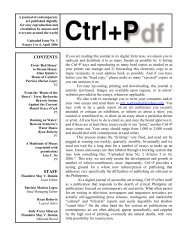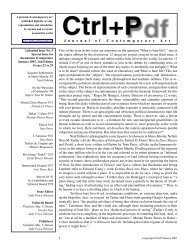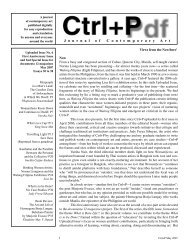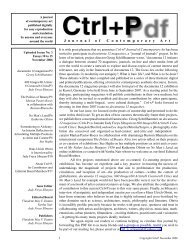Issue 15 - Pdf Ctrl+P - CTRL+P: a journal of contemporary art
Issue 15 - Pdf Ctrl+P - CTRL+P: a journal of contemporary art
Issue 15 - Pdf Ctrl+P - CTRL+P: a journal of contemporary art
Create successful ePaper yourself
Turn your PDF publications into a flip-book with our unique Google optimized e-Paper software.
The war is not over, as they say. In the mean time, private and corporate donors step<br />
in to subsidize the true costs—but only during good economic times, and usually with<br />
fickle board members or narrow grant guidelines. Moreover, most donors do not provide<br />
long-term support, and usually do not work closely with <strong>art</strong>s groups to create sustainable<br />
programs or develop income streams. From the grantseekers’ point <strong>of</strong> view, much effort<br />
has to be put into cultivating donors despite limited staff time and resources.<br />
Could the <strong>art</strong> world ever bare its true costs? It has always struggled with the precarious<br />
nature <strong>of</strong> its own un-sustainability. Moreover, politicians exploit this fissure by<br />
calling attention to controversial <strong>art</strong> that has received public funding. The politicization<br />
further distracts us from a robust debate about the values <strong>of</strong> <strong>art</strong> in society—the <strong>art</strong>s’<br />
heterogeneity makes it especially difficult to have a coherent voice and an improved set<br />
<strong>of</strong> rationales. On the other hand, the reward system for the <strong>art</strong>s is not likely to change<br />
without concerted efforts on the p<strong>art</strong> <strong>of</strong> the advocates.<br />
Endnotes<br />
1. H. Cotter, “The Boom is Over, Long<br />
Live the Art!” New York Times,<br />
<strong>15</strong> February 2009.<br />
2. G. Sandow, “The Arts need a Better<br />
Argument,” The Wall Street Journal, 18<br />
February 2009.<br />
3. W. Baumol, “Unnatural Value: or Art<br />
Investment as Floating Crap Game,”<br />
AEA Papers and Proceedings 76.2 (May<br />
1986), 10-14.<br />
4. B. Lewis, “The Second Tulip Mania,”<br />
Prospect Magazine, Dec 2008.<br />
5. Cited by B. Lewis.<br />
6. D. Kuspit, “Art Values or Market<br />
Values,” <strong>art</strong>net, March 2007.<br />
7. B. Frey, “Art Markets and Economics:<br />
An Introduction,” Journal <strong>of</strong> Cultural<br />
Economics 21(1997): 165-173.<br />
8. J. Heilbrun, “Baumol’s Cost Disease,”<br />
in Ruth Towse, Handbook <strong>of</strong> Cultural<br />
Economics (2003).<br />
9. M. Blaug, “Final Comments on the<br />
Plenary Session on Baumol and Bowen,”<br />
Journal <strong>of</strong> Cultural Economics 20 (1996):<br />
249-250.<br />
10. G. Sandow (2009).<br />
Can the Art World Recover?<br />
I realize this essay states the problem in different ways rather than give answers. But<br />
even if there were a Yellow Brick Road, the Wizard <strong>of</strong> Oz is nothing more than a quack<br />
hiding behind smoke screens and tricks. Since the <strong>art</strong> market has mostly hijacked <strong>art</strong>s’<br />
reward system and subsidies are not easily obtained with fuzzy justifications, let us turn<br />
to the issue <strong>of</strong> value creation. On behalf <strong>of</strong> <strong>art</strong>’s defense during IQ2US debate, Chuck<br />
Close asserts that, “Art is a meritocracy. It is a meritocracy because the final arbiters <strong>of</strong><br />
what is important are other <strong>art</strong>ists. All the hype, all the spin, all the effort to construct a<br />
career out <strong>of</strong> thin air, all the efforts to manipulate the market notwithstanding.”<br />
In many ways, the <strong>art</strong> world that Chuck Close describes is the ideal world when<br />
<strong>art</strong>ists have stable income and their pensions are secured and they would live without<br />
critics, curators, editors, publishers, dealers, brokers, advisers, financiers, lawyers and<br />
event planners. But consider for a moment if <strong>art</strong>ists could become better arbiters, what<br />
would this alternate <strong>art</strong> world look like? What sort <strong>of</strong> platform would allow <strong>art</strong>ists to<br />
function better as each other’s arbiters?<br />
In most industries, competition engenders innovation and spurs productivity. Lessons<br />
from recent history tell us that moments <strong>of</strong> creative fervor come in waves and despite<br />
the fact that they were brief and quickly co-opted by the mainstream—these moments<br />
usually happen when <strong>art</strong>ists work with each other rather than chase after the <strong>art</strong> market.<br />
In the 1970s in New York, Holland Cotter recalls: “…the energy was collective, but the<br />
mix was different…everybody did everything—painting, writing, performing, filming,<br />
photocopying zines, playing in bands—and new forms arrived, including hip-hop, graffiti,<br />
No Wave cinema, appropriation <strong>art</strong> and the first definable body <strong>of</strong> “out” queer <strong>art</strong>. So did<br />
unusual ways <strong>of</strong> exhibiting work: in cars, in bathrooms, in subways.”<br />
We are obviously not going to turn the clock backwards as if the same magic formula<br />
still works. For 2010 and beyond, it shall be a different story. Maybe it is time that we take<br />
a different look at what is making the world turn now. How could the <strong>art</strong>s communicate<br />
better with different sectors <strong>of</strong> the society? Are there lessons to be learned from the green<br />
revolution? Are there lessons to be learned from the infectious micr<strong>of</strong>inance movement<br />
made famous by Nobel Laureate Mohammad Yunnus? What about open source s<strong>of</strong>tware?<br />
An exhibition at the Cooper-Hewitt Museum entitled “Design for the other 90%” showed<br />
how we <strong>of</strong>ten forget that 90% <strong>of</strong> the world’s population have little or no access to products<br />
and services many <strong>of</strong> us take for granted. Nearly half <strong>of</strong> this disadvantaged population<br />
does not have regular access to food, clean water, or shelter. So why shouldn’t the <strong>art</strong>s<br />
help imagine and create different futures for everyone?<br />
10 <strong>Ctrl+P</strong> September 2009







